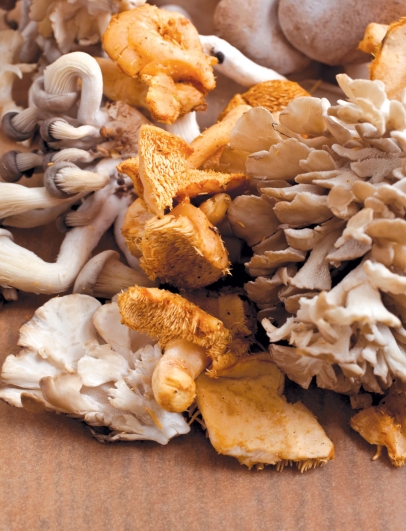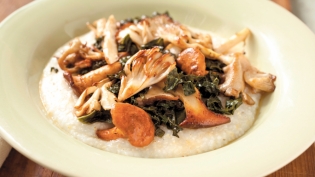Mushrooms Evoke the Taste of Fall
I grew up in Southern California in a time when mushrooms—plain white button mushrooms—were considered exotic. My mother, an adventurous cook, sought them out to make her first coq au vin from a recipe she found in a magazine—probably McCall’s or Good Housekeep- ing. I found it fascinating that she was going to cook them and serve them to her family. Would we all die?
To my uninformed eye, the soft, almost spongy mushrooms looked no different than the “toadstools” that grew in our yard one wet winter, which my mother had warned my brother and me never to touch because they might be poisonous.
But, loving to eat as I did and do, when the coq au vin came to the table, the chicken near to falling off the bones in the rich wine sauce punctuated with perfect little glazed onions and round, now brown, caps of mushrooms, I accepted a little of everything on my plate, including a few mushrooms. I remember eating a mushroom first, carefully spearing it on my fork, putting it in my mouth and savoring its flavor and texture.
Thus began my personal odyssey into the world of mushrooms.
For me, nothing evokes fall more than mushrooms because it was in my first fall of living in my French farmhouse that my neighbors introduced me to the art of gathering wild mushrooms. In the upper Var, the region where my house is, August rains are necessary for the October mushrooms to appear. That fall we’d had substantial rains, even on August 15, the date of the village’s fete of the Assumption, celebrated primarily with an extensive Grand Aioli Feast in the village square. The dancing in the square that usually followed the Feast had even been canceled due to the rain. So the mush- room season began early and with a flourish.
When one of my neighbors came by one day to show me what she’d gathered in the forest, I was horrified. Dark brown, yellowish green, mauve, orange and copper-colored fungi with pine and oak leaves still sticking to them filled her basket. But she was as excited as I had ever seen her. It seemed that the forest was full of excellent eating mushrooms—Cepes, Chanterelles, Girolles, Pied de Mouton, Bluets—and that it was going to be a great mushroom season. As she lined samples of each on my outdoor table, she recited their characteristics to me, telling me how to identify them. Tomorrow, she declared, I would go with her.
The next day, we parked the car on the edge of a forest about 10 miles away, picked up our gathering baskets and headed into the depths. I had been there in late summer, gathering dried wood, but now, in mid-October, the forest was trans- formed. The air was damp and earthy. The forest floor’s layer of pine needles lay thick and soft. Moss grew deep on the north side of the trees. It smelled like mushrooms.
I was initiated that day into what would become a lifelong passion. I discovered that I had a well-developed hunter- gatherer gene that came to the fore when confronted with a fungi habitat. Soon my basket was as full as my friend’s. I had quickly learned that a slightly swollen hump of pine needles was an indicator of a mushroom pushing up out of the earth, and that where there was one there were likely to be more. With each find, I became more and more excited, like a track- ing dog, losing sight of everything but the hunt.
I’ve continued to hunt mushrooms whenever I can, but only those I know I can identify easily because of their unique defining characteristics. Too many mushrooms are tricky to identify, and more than a few are deadly. My mother wasn’t wrong to steer me away from those toadstools—they might indeed have been poisonous.
Never, ever, would I suggest that anyone go wild mushroom hunting without an experienced forager, and even then it can be dangerous business.
The great news is that there is no need to hunt and gather wild mushrooms yourself, because we can now buy them in season at our farmers’ markets, gathered by foragers of repute. There you will find many mushroom species, both wild and farm-raised. The variety is astonishing, the flavors and appearance distinct.
If you are interested in learning about wild mushrooms in our region, two local societies offer mushroom hunting forays, educational events and even special dinners. Visit their websites for more information.
Sonoma County Mycological Association SOMAMushrooms.org | Mycological Society of San Francisco MSSF.org






